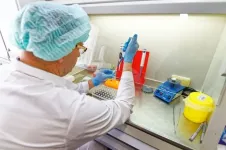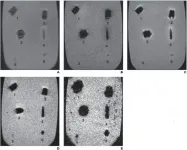Flag leaves could help top off photosynthetic performance in rice
2021-01-02
(Press-News.org) The flag leaf is the last to emerge, indicating the transition from crop growth to grain production. Photosynthesis in this leaf provides the majority of the carbohydrates needed for grain filling--so it is the most important leaf for yield potential. A team from the University of Illinois and the International Rice Research Institute (IRRI) found that some flag leaves of different varieties of rice transform light and carbon dioxide into carbohydrates better than others. This finding could potentially open new opportunities for breeding higher yielding rice varieties.
Published in the Journal of Experimental Botany, this study explores flag leaf induction--which is the process that the leaf goes through to "start up" photosynthesis again after a transition from low to high light. This is important because the wind, clouds, and movement of the sun across the sky cause frequent fluctuations in light levels. How quickly photosynthesis adjusts to these changes has a major influence on productivity.
For the first time, these researchers revealed considerable differences between rice varieties in the ability of flag leaves to adjust to fluctuating light. They also showed that the ability to adjust differs between the flag leaf and leaves formed before flowering. Six rice varieties chosen to represent the breadth of genetic variation across a diverse collection of more than 3000 were analyzed as a first step in establishing if there was variation in ability to cope with fluctuations in light.
In this study, they discovered the flag leaf of one rice variety that began photosynthesizing nearly twice (185%) as fast as the slowest. Another top-performing flag leaf fixed 152% more sugar. They also found large differences (77%) in how much water the plant's flag leaves exchanged for the carbon dioxide that fuels photosynthesis. Additionally, they found that water-use efficiency in flag leaves correlated with water-use efficiency earlier in development of these rice varieties, suggesting that water-use efficiency in dynamic conditions could be screened for at younger stages of rice development.
"What's more, we found no correlation between the flag leaf and other leaves on the plant, aside from water-use efficiency, which indicates that both kinds of leaves may need to be optimized for induction," said Stephen Long, Illinois' Ikenberry Endowed University Chair of Crop Sciences and Plant Biology. "While this means more work for plant scientists and breeders, it also means more opportunities to improve the plant's photosynthetic efficiency and water use. Improving water use is of increasing importance, as agriculture already accounts for over 70% of human water use, and rice is perhaps the largest single part of this."
Confirming their previous study in New Phytologist, they found no correlation between data collected in fluctuating and steady-state conditions, where the rice plants were exposed to constant high light levels. This finding adds to a growing consensus that researchers should move away from research dependent on steady-state measurements.
"We're realizing the need for our experiments to more accurately reflect the reality that these plants experience out the field," said first-author Liana Acevedo-Siaca, a postdoctoral researcher at Illinois. "We need to focus our efforts on capturing the dynamic conditions so we can improve crops to be productive in the real world, not laboratories."
INFORMATION:
This work is part of Realizing Increased Photosynthetic Efficiency (RIPE), a project that aims to improve photosynthesis to equip farmers worldwide with higher-yielding crops to ensure everyone has enough food to lead a healthy and productive life. RIPE is sponsored by the Bill & Melinda Gates Foundation, the U.S. Foundation for Food & Agriculture Research, and the U.K. Foreign, Commonwealth & Development Office who are committed to ensuring Global Access and making the project's technologies available to the farmers who need them the most.
ELSE PRESS RELEASES FROM THIS DATE:
2021-01-02
In a study that looked at suicide deaths during 2020's first wave of the COVID-19 pandemic in Maryland, Johns Hopkins Medicine researchers found that, contrary to general predictions of suicides skyrocketing, suicides in the overall population actually dropped, relative to previous years. However, the researchers also discovered that suicide deaths increased dramatically among Black Marylanders during the same period.
The researchers say that their findings, published Dec. 16, 2020, in JAMA Psychiatry, highlight the importance of timely identification of high-risk groups and vulnerable populations to reduce suicide numbers.
Black Americans have been ...
2021-01-02
LOS ANGELES -- Scientists from the UCLA Jonsson Comprehensive Cancer Center have developed a simple, high-throughput method for transferring isolated mitochondria and their associated mitochondrial DNA into mammalian cells. This approach enables researchers to tailor a key genetic component of cells, to study and potentially treat debilitating diseases such as cancer, diabetes and metabolic disorders.
A study, published today in the journal Cell Reports, describes how the new UCLA-developed device, called MitoPunch, transfers mitochondria into 100,000 or more recipient cells simultaneously, which is a significant improvement from existing mitochondrial transfer technologies. The device is ...
2021-01-02
AURORA, Colo. (Dec. 29, 2020) - College football players may underestimate their risk of injury and concussion, according to a new study published today in JAMA Network Open.
Christine Baugh, PhD, MPH, assistant professor of medicine at the University of Colorado School of Medicine and member of the CU Center for Bioethics and Humanities, is the corresponding author of the article, "Accuracy of US College Football Players' Estimates of Their Risk of Concussion or Injury."
Baugh and co-authors report on survey results of 296 college football players from four teams in the Power 5 Conferences of ...
2021-01-02
People have puzzled for years why pathogen Phytophthora infestens causes the devastating late blight disease, source of the Irish Potato famine, on potatoes, but has no effect at all on plants like apple or cucumber. How are apple trees and cucumber plants able to completely shake off this devastating pathogen? Agricultural scientists have wondered for years: if this resistance is so complete and persists over so many generations, is there some way we could transfer it to susceptible plants like wheat and thereby stop disease?
Why is it so important to determine the molecular basis of nonhost resistance? ...
2021-01-02
Toronto - With the arrival of effective vaccines for the COVID-19 virus, the end of the pandemic is on the horizon but in the short term the virus continues to spread.
A timely new study published today by PLOS ONE examines the effectiveness of COVID-19 control policies in 40 jurisdictions including countries and U.S. states.
Among the conclusions is that significant social costs must be incurred to reduce the growth of the virus below zero. In most jurisdictions examined, policies with a lesser social impact including cancellation of public events, restrictions of gatherings ...
2021-01-02
The Grain Chain, a farm to fork coalition of stakeholders in the grain industry sector and chaired by the American Bakers Association (ABA), celebrates the recommendation published today in the 2020-2025 Dietary Guidelines for Americans (DGAs) to "consume half of your grains from whole grain sources" and the remainder from enriched grains. A foundational piece of the DGAs, the guidelines recognize whole grains are "one of the three food groups that are fundamental constituents of a healthy dietary pattern."
The United States Department of Agriculture (USDA) and Health and Human Services (HHS) oversee and publish the Dietary Guidelines, ...
2021-01-02
BIRMINGHAM, Ala. - COVID-19, which has killed 1.7 million people worldwide, does not follow a uniform path.
Many infected patients remain asymptomatic or have mild symptoms. Others, especially those with comorbidities, can develop severe clinical disease with atypical pneumonia and multiple system organ failure.
Since the first cases were reported in December 2019, the SARS-CoV-2 virus that causes COVID-19 has surged into a pandemic, with cases and deaths still mounting. Ongoing observational clinical research has become a priority to better understand how this previously unknown virus acts, and findings from this research can better inform treatment and vaccine design.
University ...
2021-01-02
Carrageenans, biologically active polysaccharides isolated from red algae and widely used in the food industry as stabilizers, thickeners, or jelly agents have an express effect on the immune systems of mice, a study reports. The research was carried out by scientists from the School of Biomedicine of Far Eastern Federal University (FEFU), Far Eastern Branch of the Russian Academy of Sciences, and Vilnius University. A related article appears in the Journal of Biomedical Materials Research.
"The fact that carrageenan demonstrates immunosuppressive properties in a particular case does not make it generally dangerous or toxic though", says Aleksandra ...
2021-01-02
Leesburg, VA, December 29, 2020--According to an article in ARRS' American Journal of Roentgenology (AJR), because patients with ballistic embedded fragments are frequently denied MRI (due to indeterminate bullet composition sans shell casings), radiography and CT can be used to identify nonferromagnetic projectiles that are safe for MRI.
"Commercially available handgun and shotgun ammunition representing projectiles commonly encountered in a clinical setting was fired into ballistic gelatin as a surrogate for human tissue," explained first author Arthur J. Fountain from the department of radiology and imaging sciences at Emory ...
2021-01-02
While the world has its eyes on vaccines to stop the spread of coronavirus, therapeutics are still necessary to treat hospitalized patients. One of these treatments, remdesivir, is the first and only antiviral agent of its kind that the U.S. Food and Drug Administration (FDA) has approved so far for COVID-19.
Research at the University of Cincinnati, however, contends that this antiviral drug is being used too indiscriminately when treating patients hospitalized with the virus. The study is published in the journal Fundamental & Clinical Pharmacology.
The FDA approved remdesivir, marketed as Veklury, for emergency use authorization in May 2020 to treat COVID-19 and granted full approval ...
LAST 30 PRESS RELEASES:
[Press-News.org] Flag leaves could help top off photosynthetic performance in rice






